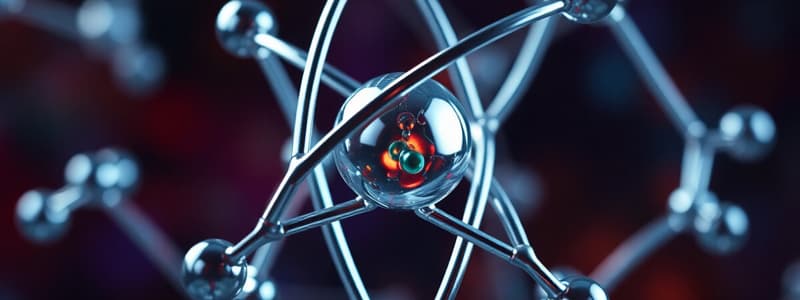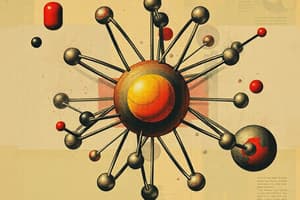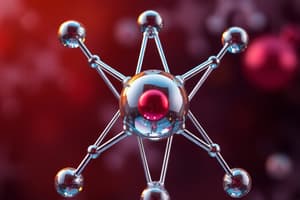Podcast
Questions and Answers
What is the primary purpose of balancing chemical equations?
What is the primary purpose of balancing chemical equations?
- To ensure conservation of mass (correct)
- To change the state of matter
- To classify types of chemical reactions
- To increase the rate of reaction
Which of the following statements about solids is true?
Which of the following statements about solids is true?
- Solids take the shape of their container
- Solids have neither a fixed shape nor volume
- Solids have a fixed shape and volume (correct)
- Solids have a definite shape but no volume
How is molarity defined?
How is molarity defined?
- Mass of solute per volume of solution
- Amount of solute per volume of solvent
- Volume of solute per mass of solvent
- Amount of solute per volume of solution (correct)
What does a pH of 7 indicate?
What does a pH of 7 indicate?
Which law states that energy cannot be created or destroyed?
Which law states that energy cannot be created or destroyed?
What does the term 'entropy' measure?
What does the term 'entropy' measure?
Which reaction type involves the breakdown of a compound into two or more products?
Which reaction type involves the breakdown of a compound into two or more products?
What happens during the process of vaporization?
What happens during the process of vaporization?
What defines the element of an atom?
What defines the element of an atom?
What is the mass number of an atom?
What is the mass number of an atom?
Which type of bond forms when one atom loses electrons to another?
Which type of bond forms when one atom loses electrons to another?
What characterizes nonpolar covalent bonds?
What characterizes nonpolar covalent bonds?
Which statement is true about metalloids?
Which statement is true about metalloids?
In a chemical equation, what do the reactants represent?
In a chemical equation, what do the reactants represent?
Which group of elements typically shows similar chemical properties?
Which group of elements typically shows similar chemical properties?
What indicates the average mass of all isotopes of an element?
What indicates the average mass of all isotopes of an element?
Flashcards
Atomic Structure
Atomic Structure
Atoms are the basic building blocks of matter, made of a nucleus (protons and neutrons) surrounded by electrons.
Atomic Number
Atomic Number
The number of protons in an atom, defining the element.
Isotopes
Isotopes
Atoms of the same element with different numbers of neutrons.
Chemical Bond
Chemical Bond
Signup and view all the flashcards
Ionic Bonding
Ionic Bonding
Signup and view all the flashcards
Covalent Bonding
Covalent Bonding
Signup and view all the flashcards
Periodic Table
Periodic Table
Signup and view all the flashcards
Chemical Reaction
Chemical Reaction
Signup and view all the flashcards
States of matter
States of matter
Signup and view all the flashcards
Chemical reaction types
Chemical reaction types
Signup and view all the flashcards
Solution
Solution
Signup and view all the flashcards
Solute
Solute
Signup and view all the flashcards
Solvent
Solvent
Signup and view all the flashcards
Concentration
Concentration
Signup and view all the flashcards
Acids
Acids
Signup and view all the flashcards
First Law of Thermodynamics
First Law of Thermodynamics
Signup and view all the flashcards
Study Notes
Atomic Structure
- Atoms are the fundamental building blocks of matter, composed of a nucleus containing protons and neutrons, surrounded by electrons.
- Protons have a positive charge, neutrons are neutral, and electrons have a negative charge.
- The number of protons defines the element.
- Atomic number = number of protons.
- Mass number = number of protons + number of neutrons.
- Isotopes are atoms of the same element with different numbers of neutrons.
- Atomic mass is the average mass of all isotopes of an element.
- Electrons orbit the nucleus in specific energy levels or shells.
- Each shell can hold a maximum number of electrons.
- Valence electrons are the electrons in the outermost shell, and they play a crucial role in chemical bonding.
Chemical Bonding
- Chemical bonds hold atoms together to form molecules and compounds.
- Ionic bonding occurs when one atom loses electrons to another, forming positively and negatively charged ions that attract each other.
- Covalent bonding occurs when atoms share electrons to achieve a stable electron configuration.
- Polar covalent bonds occur when electrons are shared unequally between atoms, resulting in a partial positive and negative charge.
- Nonpolar covalent bonds occur when electrons are shared equally.
- Metallic bonding occurs in metals, where electrons are delocalized and move freely throughout the structure.
Periodic Table
- The periodic table organizes elements based on their atomic number and properties.
- Elements with similar properties are grouped in vertical columns called groups or families.
- Elements with increasing atomic number are arranged horizontally in periods.
- Metals are generally good conductors of heat and electricity, malleable, and ductile.
- Nonmetals are typically poor conductors of heat and electricity, and they are brittle.
- Metalloids have properties that are intermediate between metals and nonmetals.
- Elements are classified as alkali metals, alkaline earth metals, transition metals, halogens, noble gases, etc.
- The periodic table can be used to predict the properties of elements based on their position on the table.
Chemical Reactions
- Chemical reactions involve the rearrangement of atoms to form new substances.
- Reactants are the substances that undergo change, and products are the substances formed.
- A chemical equation represents a chemical reaction, showing the reactants and products with their respective formulas and stoichiometric coefficients.
- Balancing chemical equations ensures that the number of atoms of each element is the same on both sides of the equation.
- Chemical reactions can be classified into different types, such as synthesis, decomposition, single displacement, double displacement, and combustion reactions.
States of Matter
- Matter exists in three fundamental states: solid, liquid, and gas.
- Solids have a fixed shape and volume.
- Liquids have a definite volume but take the shape of their container.
- Gases have neither a fixed shape nor a fixed volume; they expand to fill their container.
- Changes of state (melting, freezing, vaporization, condensation, sublimation, deposition) occur when heat is added or removed.
- These transitions involve changes in the arrangement and energy of molecules.
Solutions
- A solution is a homogeneous mixture of two or more substances.
- The solute is the substance that dissolves, and the solvent is the substance that dissolves the solute.
- Solutions can be solids dissolved in liquids, liquids dissolved in liquids, gases dissolved in liquids, or gases dissolved in gases.
- Concentration expresses the amount of solute present in a given amount of solvent or solution.
- Molarity, molality, and percent concentration are different ways to measure the concentration.
Acids and Bases
- Acids are substances that produce hydrogen ions (H+) when dissolved in water.
- Bases are substances that produce hydroxide ions (OH-) when dissolved in water.
- The pH scale measures the acidity or basicity of a solution, ranging from 0 to 14.
- A pH of 7 is neutral, a pH below 7 is acidic, and a pH above 7 is basic.
- Strong acids and bases completely dissociate in water, whereas weak acids and bases only partially dissociate.
- Indicators are substances that change color depending on the pH of a solution.
Thermodynamics
- Thermodynamics deals with energy transformations in chemical and physical processes.
- The first law of thermodynamics states that energy can be neither created nor destroyed, only transformed.
- The second law of thermodynamics states that the total entropy of an isolated system can only increase over time.
- The third law of thermodynamics states that the entropy of a perfect crystal at absolute zero is zero.
- Enthalpy is the heat content of a system at constant pressure.
- Entropy measures the degree of disorder or randomness in a system.
Kinetics
- Chemical kinetics deals with the rates of chemical reactions.
- Reaction rates depend on factors such as temperature, concentration of reactants, and the presence of catalysts.
- Reaction mechanisms describe the steps involved in a chemical reaction.
- Catalysts speed up reactions by providing an alternative reaction pathway with a lower activation energy.
- Reaction order describes how the rate of a reaction depends on the concentration of reactants.
Studying That Suits You
Use AI to generate personalized quizzes and flashcards to suit your learning preferences.
Description
Explore the fundamental concepts of atomic structure and chemical bonding in this quiz. Learn about atoms, protons, neutrons, electrons, and the different types of chemical bonds. Test your understanding of how these concepts are essential to the formation of molecules and compounds.




